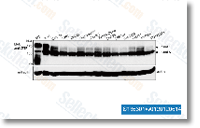These findings sug gest that a large quantity of amniocyte proteins are expressed in distinctive amounts involving the CN and T21 conditions. You will find a minimum of two reasons as to why our quantifi cation primarily based on SILAC may perhaps potentially possess a comparatively large variability. First, amniocytes in major culture do not represent a homogenous population, unlike most other cell cultures. It has been observed previously, also as within the current study, that only a subset of amnio cytes survive supplier Palbociclib following a few doubling instances and also the amnio cyte cultures develop into reasonably homogeneous, even though the precise nature of these cells are but to be determined. Second, the amniocytes utilised in this study origi nated from various individuals. As a result, the results have been expected to become substantially far more variable, com pared to research that use immortalized cells from one in dividual.
Offered that proteins that show differential expression in only selleck chemicals one particular experimental pair may possibly be resulting from analytical variability, only proteins that showed differen tial expression across two or much more experimental pairs from our initial list of 904 proteins were retained for fur ther evaluation. Right here, we employed SRM assay for verifica tion of SILAC data, due to the fact we’ve got previously validated its accuracy and effectiveness for verification of candi dates in amniotic fluid. Network modeling recommended that a variety of path methods incorporate a number of proteins which can be identified in our list of dysregulated proteins. For example, a path way that includes NF B was one of our major 3 pathways, and NF B, along with NFATc, has been implicated within the dysregulation of DS candidate area 1.
An other pathway that contains APP was certainly one of our major 3 pathways, and 29  out of the 35 involved proteins of this distinct network had been identified in our list of 904 pro teins that appear to become dysregulated. APP gene encodes a transmembrane protein known as amyloid precursor protein in humans, which could be sequentially cleaved by the ac tion with the B and secretases, to generate amyloid beta peptides. APP protein and its peptides appear to con tribute towards the pathogenesis of DS by both gain of toxic functions and loss of typical biological functions. AB42 peptide could be the main constituent of amyloid plaques which can be a hallmark of Alzheimers illness, and current studies have suggested that the cognitive decline in Alzheimers is mediated by reduction of synaptic plasticity attributed for the AB plaque formation. AB peptides may also result in cerebral amyloid angiopathy, as these peptides ag gregate to coat cerebral blood vessels. Plaques indicating amyloid angiopathy have also been observed in DS affected brains. While the exact function of APP is unknown, APP appears to play a crucial part in dif ferentiation or migration processes of neural stem cells.
out of the 35 involved proteins of this distinct network had been identified in our list of 904 pro teins that appear to become dysregulated. APP gene encodes a transmembrane protein known as amyloid precursor protein in humans, which could be sequentially cleaved by the ac tion with the B and secretases, to generate amyloid beta peptides. APP protein and its peptides appear to con tribute towards the pathogenesis of DS by both gain of toxic functions and loss of typical biological functions. AB42 peptide could be the main constituent of amyloid plaques which can be a hallmark of Alzheimers illness, and current studies have suggested that the cognitive decline in Alzheimers is mediated by reduction of synaptic plasticity attributed for the AB plaque formation. AB peptides may also result in cerebral amyloid angiopathy, as these peptides ag gregate to coat cerebral blood vessels. Plaques indicating amyloid angiopathy have also been observed in DS affected brains. While the exact function of APP is unknown, APP appears to play a crucial part in dif ferentiation or migration processes of neural stem cells.
PAFR Signal
PAFR has won the GFOA
